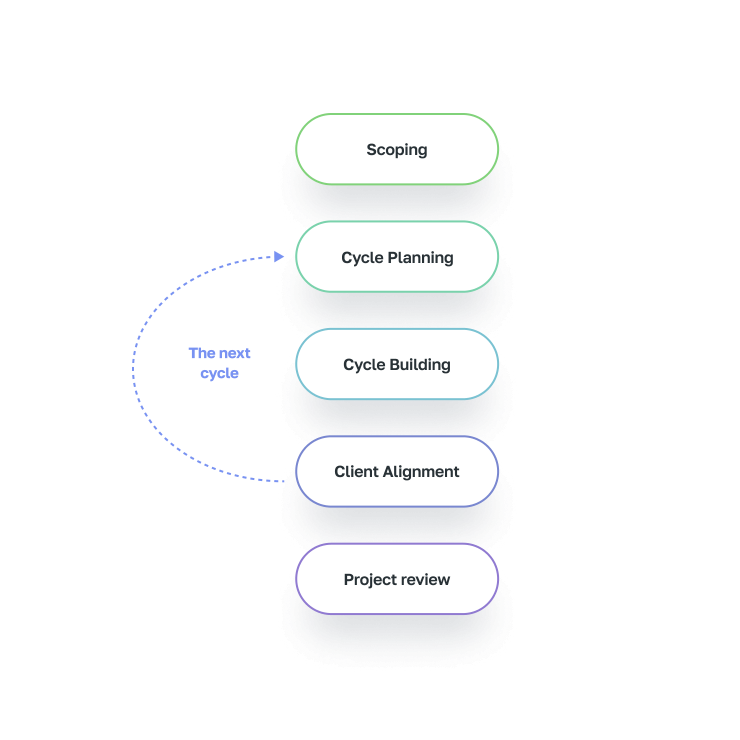Today on the Worksection blog, we will discuss adaptive project frameworks.
For many modern projects, traditional project management (TPM) models are unsuitable. They fail to address the challenges that arise today when launching projects: constant changes, unclear business goals, and competitor actions. Establishing complete requirements at the initial stage has become unrealistic, necessitating adjustments throughout the entire cycle.
Therefore, cyclical and recursive models are current tools for project managers. The ability to review past work stages, improve the current iteration, or constantly check and update data is invaluable.
The goal of the Adaptive Project Framework (APF) method is to harmonize processes and constant changes in the project, business climate, and markets. It does not prescribe templates and a list of pre-prepared solutions. Changes in the approach are an unconventional response to changes in the project or the surrounding environment.
The method’s author, Robert K. Wysocki, insists that the project manager (PM) should act not as a cook but as a chef. There is no need to follow recipes when the absence of an ingredient will lead to a delay – one must invent them independently and not rely on the availability of necessary components. According to Wysocki’s observations, linear TPM models are unsuitable for 70% of projects.
Seven Independent Factors Affecting a Project
Wysocki highlights seven independent factors that impact a project:
- Characteristics of the environment in which the project will be implemented
- Characteristics of the project itself
- Life cycle of the business process
- Life cycle of project management
- Competence of the project team
- Client’s vision
- Quality of equipment or software
Principles of APF
- Client Focus: The client is responsible for choosing the tools and approaches for the project, but they receive support from the project team (PT).
- Client Dependence: APF involves greater client involvement than most project managers are used to. They must be prepared to act as consultants supporting the client throughout the project. The client decides whether to continue or terminate the project.
- Quick and Frequent Demonstration of Results: Cycles in APF are short, allowing the client to quickly learn about the current results and be more engaged in the processes.
- Readiness to Constantly Ask Questions and Analyze: Many phases of APF are based on questions that the PT and client must answer.
- Changes Lead to Better Solutions: The frequency of changes in an APF project is a good indicator of how the parties are moving towards the desired solution. Ideally, changes occur frequently in early cycles and slow down later. Unlike TPM, APF views changes as a sign of a healthy project.
- Do Not Speculate on the Future: If we do not know the future, why plan? Forecasting the future is considered a process that does not add value.
APF Algorithms

Phase 1: Scoping
This initial phase establishes project goals that both the PT and client must clearly understand. The success criteria are fixed as the result that brings obvious business value.Scoping is performed in five stages:
- Finding Conditions for Compliance: A meeting between the PT and client representatives ensures mutual understanding and resolution of any contradictions.
- Drafting a Project Overview Statement: This document highlights the issues and opportunities prompting the project, project goals, scope, success criteria, and risks.
- Defining Cycle Parameters: Setting the duration and number of cycles.
- Establishing an Incomplete Hierarchical Work Structure or Project Schedule: Known goals without predefined tools, supplemented during the project as important details emerge.
- Prioritizing Algorithms: Determining priority tools and approaches for future use.
Phase 2: Cycle Planning
Cycle planning involves only processes with already selected solutions and is divided into four stages:
- Defining Cycle Goals: Discussed with the client, considering time and resources.
- Assigning Tasks for Establishment: Initial step towards forming a project schedule.
- Creating Schedules for Dependent Processes: Using tools like Kanban.
- Subteam Work: Finalizing schedules for each subteam.
Phase 3: Cycle Building
Unlike TPM, cycle execution time in APF never changes and remains as established in the first phase. No changes are implemented during the cycle; new approaches are adopted between cycles.
Tools used:
- Micro-level Schedules: Subteams create work plans for sub-tasks.
- Work Packages: Describe how a performer intends to complete sub-tasks.
- Change Request Repository: Proposals are reviewed after the cycle ends.
- Issue Information: Describes problems, risks, and situations needing clarification.
- Daily PT Meetings: Quick status updates without problem-solving discussions.
Phase 4: Client Alignment
A unique phase where PT and the client engage in decisive negotiations to analyze the project:
- Evaluate processes completed on time.
- Decide whether to proceed to the next cycle.
- Review change requests, unused tools and resources, and set new priorities.
- Define goals for the next cycle.

Designed by Jcomp / Freepik
Phase 5: Project Review
Questions to address:
- Did the team find an acceptable solution?
- Did the algorithms work for the project?
- How well did the team use APF algorithms?
Implementing APF
As mentioned, APF originated during two projects, one ordered by retailer Snacks Fifth Avenue and another by Kamikazi Software Systems.
Example: Snacks Fifth Avenue
In 2008, Snacks Fifth Avenue was approaching its 50th anniversary with declining sales and customer flow. Director Patty Forz wanted to attract new customers with kiosks providing information about local restaurants and cinemas, inspired by similar setups in nearby malls.

Project Overview Statement for Snacks Fifth Avenue:
- Project Name: “Kiosk Design”
- Project Number: 08 – 01
- Project Manager: T. Coffee
- Problems/Opportunities: Decreasing store visits and sales, needing a change.
- Goal: Restore sales levels, increase foot traffic, and create something engaging for customers.
- Scope: Develop a kiosk concept with multiple services, attract customers to specific products, create product bundles for events, and more.
- Success Criteria: Restore sales levels within two quarters, offer at least four services each generating at least 5% of sales, and implement a customer-desired service generating 5% of sales by the second quarter.
- Risks: Customers may dislike the kiosk idea.
Process and Outcome
Over six months, several prototypes were created and tested. Questions addressed included kiosk operation via keys or touchscreens, print receipts, product issuance, order placement, and support services. A focus group provided feedback on the prototypes.The final design launched in stores, improving sales and customer interest, meeting the project’s goals.
Verdict
- APF requires a new mindset, ready for changes.
- The method is continually updated.
- Based on the “just-in-time” concept.
- TPM tools, templates, and processes are adapted to new formats.
- APF is client-focused, ensuring full communication and trust.
- Identifies all processes that do not add value.

